AMD Launches Mobile Kaveri APUs
by Jarred Walton on June 4, 2014 12:01 AM ESTAMD Kaveri FX-7600P GPU Performance Preview
Given the 3DMark results we just showed as well as the increase in CPU performance, I was very interested to see what Kaveri could do in terms of gaming performance. Here I have to temper my comments somewhat by simply noting that the graphics drivers on the prototype laptops did not appear to be fully optimized. One game in particular that I tested (Batman: Arkham Origins) seemed to struggle more than I expected, and there are other games (Metro: Last Light and Company of Heroes 2) that will bring anything short of a mainstream dGPU to its knees. I've posted the Kaveri Mainstream and Enthusiast scores in Mobile Bench, but they're not particularly useful as most of the scores are below 30 FPS. Here, I'll focus on our "Value" settings, which are actually still quite nice looking (Medium detail in most games).
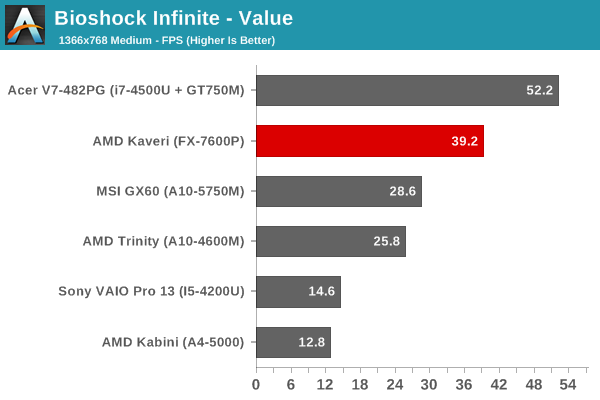
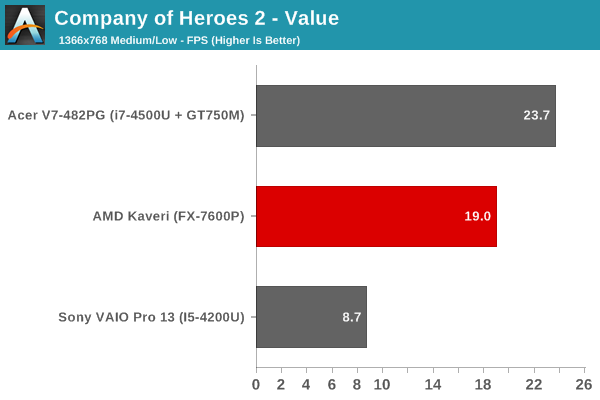
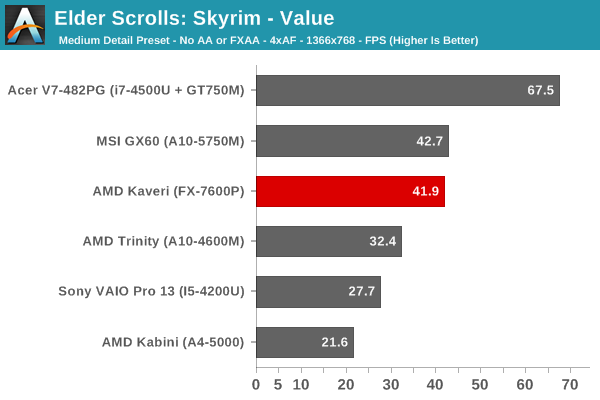
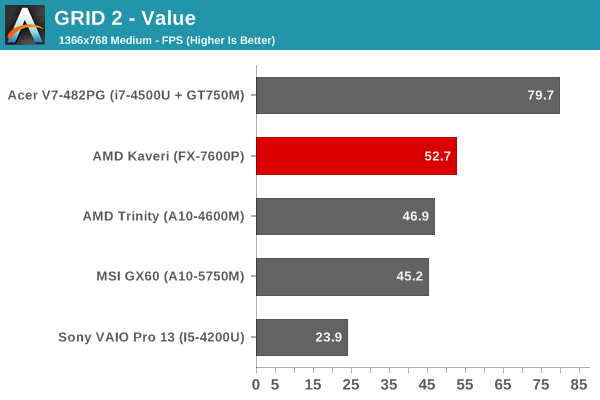

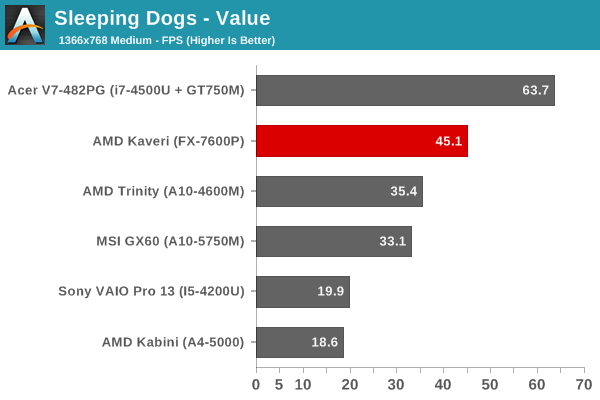
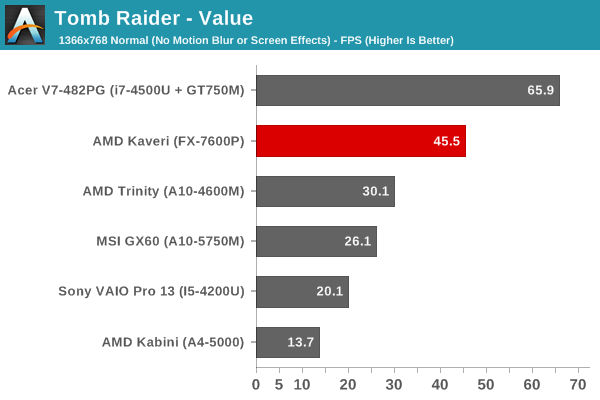
As expected, in most of the tests the Kaveri APU is able to surpass the gaming performance of every other iGPU, and in some cases it even comes moderately close to a discrete mainstream dGPU. There's a sizeable gap between the Trinity/Richland APUs and Kaveri in most of the games I tested, which is great news for those looking for a laptop that won't break the bank but can still run most modern games.
Getting into the particulars, Skyrim seems to be hitting some bottleneck (possibly CPU, though even then I'd expect Kaveri to be faster than Richland), but the vast majority of games should run at more than 30 FPS. There was one system with a pre-release Mantle driver installed that was running Battlefield 4 reasonably well at low/medium details, and with shipping laptops and drivers (and perhaps DDR3-2133 RAM) I suspect even Metro might get close to 30 FPS. Of course, we're only looking at the top performance FX-7600P here, so we'll have to see what the various 19W APUs are able to manage in similar tests.










125 Comments
View All Comments
Flunk - Wednesday, June 4, 2014 - link
Under clocking the CPU and overclocking the GPU. that would be helpful. I've actually done this in a laptop that shares coolers between a discrete GPU and CPU but I imagine it would be useful in an APU laptop too.E.G. Note that the CPU is not underclocked in this test but I do normally underclock it to reduce the volume of the fan.
http://www.3dmark.com/3dm11/6039951
Meaker10 - Friday, June 6, 2014 - link
The GS60 with M290x, with an a10-5750 it's a questionably balanced system, with an ad 5550m at 3.6-3.7ghz it offers a great deal of value.Meaker10 - Friday, June 6, 2014 - link
Damn auto correct, gx60 not gs60.vladx - Wednesday, June 4, 2014 - link
There's a mistake on the 3rd page, it should be i5-4200U not 5200U afaik.texasti89 - Wednesday, June 4, 2014 - link
I looked straight for the single-threaded performance and I see the 15w 4500u gets >50% higher score than the 35W 7600P. Yes, graphics is good at that high TDP, but without a competitive CPU performance I think it's hard to justify these SKUs for the target market. AMD really needs to stop this disastrous adoption of bulldozer-based CPUs for good.
TrackSmart - Wednesday, June 4, 2014 - link
Three thoughts:1) I'm not defending AMD's single core performance, but the single-threaded cinebench test shows a 33% lead for the Intel Core-i5, which is not "greater than 50%". That said, I agree that AMD needs to close the gap on single-threaded CPU performance (and CPU performance-per-watt). This is as close as they've been in a long time, but the gap is still large. Their grand strategy has supposedly been to leverage the interaction of CPU+GPU to provide better performance, but when you are the minority player in the chip market, that's a tough hill to climb. How can you get software makers to write code for your APUS when they are only a fraction of the market *and* mostly found in the lowest-end consumer laptops?
2) Sure, multi-threaded CPU performance looks competitive here since AMD has thrown in more "cores" (purposeful use of quotation marks) for the same price as Intel, but that strategy can only go so far. At any time, Intel can choose to lower the price on its chips to match AMDs performance-per-dollar because Intel's chips use less silicon to produce the same CPU performance.
3) Anand is right that AMD needs to get these chips into nice laptops -- with lower-than-Intel prices -- and emphasize the gaming performance advantage. And those laptops had better have good battery life under normal usage. The presumed niche would be for an AMD laptop with reasonable gaming chops at several hundred dollars less than an Intel laptop with a discrete GPU.
That said, 35 watts is too high for the ultrabook form factor. Will AMDs graphics advantage remain this large when you move down to a 15 Watt APU? If the answer is no, then Anand's ideal doesn't really work. All you would get is a $50 cheaper AMD laptop with slower CPU performance and similar GPU performance!
[Note: I'm really rooting for AMD, but I'm going to remain cautious in my enthusiasm for these new chips until I see them in actual laptops. As they say, the proof is in the pudding.]
Natfly - Wednesday, June 4, 2014 - link
> I'm not defending AMD's single core performance, but the single-threaded cinebench test shows a 33% lead for the Intel Core-i5, which is not "greater than 50%".1.33 / .87 = 1.53. 53% faster.
TrackSmart - Thursday, June 5, 2014 - link
Yes, but the core i5 I specifically refer to is only a 33% difference. I'm guessing you were looking at the i7. So we are both wrong and both right. And in agreement about the need for better single threaded performance.piroroadkill - Wednesday, June 4, 2014 - link
Nice chip. But that said, without battery life results, this review does fall flat, I understand that they couldn't be done, though.Other than that, you've touched on the main issue with AMD based laptops: nobody wants to make a good one.
Give me something like my old Sony Vaio Z12 with that FX-7600P in it, at a decent price, and you have a compelling product. I don't want ridiculous resolutions. I want one that will work well for games and desktop use at a nice size. The Z12 @ 13.1" 1600×900 offers that absolutely perfectly in my opinion.
Homeles - Wednesday, June 4, 2014 - link
"From what I could gather, AMD used "V" transistors in Trinity/Richland but has switched to "T" transistors for Kaveri, which explains the drop in maximum clock speed."Perhaps, but the most important reason was the regression from PD-SOI to bulk.
Interesting claim there about the transistor "shapes." I've not heard of T and V shaped transistors... it appears to be the shape of the gate.